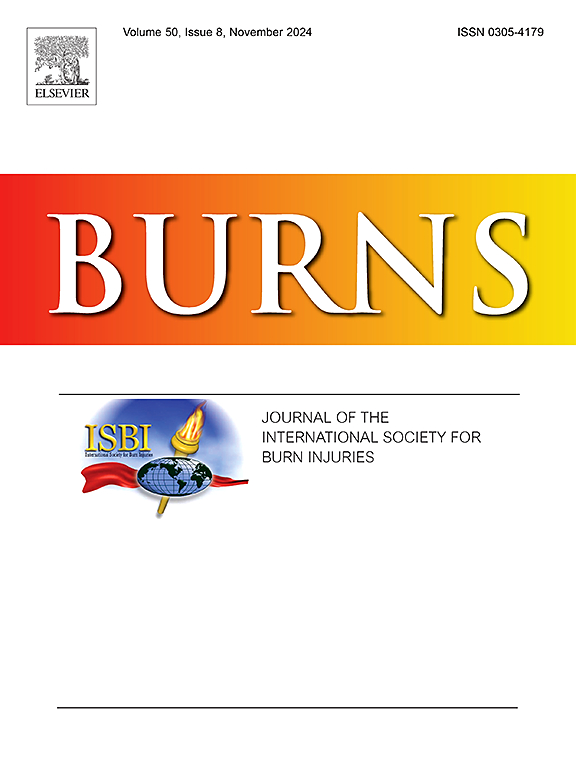Cross cultural adaptation and validation of the Latin American Spanish version of the Burn Specific Health Scale-Brief (BHSH-BE) questionnaire
IF 2.9
3区 医学
Q2 CRITICAL CARE MEDICINE
引用次数: 0
Abstract
Introduction
The Burn-Specific Health Scale-Brief (BSHS-B) questionnaire is a widely validated tool for assessing health-related quality of life (HRQoL) in patients with burns. There is no version appropriate for low- and middle-income Spanish-speaking countries. This study aimed to translate, culturally adapt, and psychometrically validate a version in Latin American Spanish (BSHS-BE).
Methods
First, we translated and culturally adapted the BSHS-B into Latin American Spanish. Then, the questionnaire underwent psychometric validation and reliability evaluation using the Short-Form 36 Health Survey and the Patient Health Questionnaire-2.
Results
The BSHS-BE assessed the clinical relevance of each item in terms of content validity. The BSHS-BE demonstrated good discriminatory ability in patients with hand or face burns, TBSA > 15 %, required surgical intervention, and those at risk of depressive disorder. The relationship between the BSHS-BE and SF-36 was analyzed by estimating the correlation coefficients using Spearman’s rank. An exploratory factor analysis (EFC) was conducted using a seven-domain model, extracting factors using the Velicer Partial Mean Averages test, and analyzing with a maximum likelihood factor extraction with oblimin rotation to compute the factor structure of items of the BSHS-BE, explaining 71 % of variability. Internal consistency was determined for the BSHS-BE using Cronbach’s alpha for each domain and the total score.
Conclusion
The BSHS-BE is a valid, reliable, and culturally adapted tool for assessing the HRQoL of patients with burns, which supports multidisciplinary management, thereby improving quality of life.
拉丁美洲西班牙语版烧伤特定健康量表(BHSH-BE)问卷的跨文化适应和验证
烧伤特异性健康量表-简要(BSHS-B)问卷是一种广泛验证的评估烧伤患者健康相关生活质量(HRQoL)的工具。没有适合中低收入西班牙语国家的版本。本研究旨在对拉丁美洲西班牙语(BSHS-BE)的一个版本进行翻译、文化适应和心理计量学验证。方法首先,我们将BSHS-B翻译成拉丁美洲西班牙语并进行文化改编。然后,采用《36健康问卷简表》和《患者健康问卷-2》对问卷进行心理计量学验证和信度评估。结果BSHS-BE量表从内容效度方面评估了各条目的临床相关性。BSHS-BE在手部或面部烧伤患者、TBSA >; 15 %、需要手术干预的患者和有抑郁障碍风险的患者中表现出良好的区分能力。利用Spearman秩估计相关系数,分析BSHS-BE与SF-36之间的关系。采用七域模型进行探索性因子分析(EFC),采用Velicer偏均值检验提取因子,并采用oblimin旋转的最大似然因子提取进行分析,计算出BSHS-BE项目的因子结构,解释了71% %的变异。使用Cronbach 's alpha对每个域和总分确定BSHS-BE的内部一致性。结论BSHS-BE是评估烧伤患者HRQoL的有效、可靠、文化适应性强的工具,可支持多学科管理,从而提高患者的生活质量。
本文章由计算机程序翻译,如有差异,请以英文原文为准。
求助全文
约1分钟内获得全文
求助全文
来源期刊

Burns
医学-皮肤病学
CiteScore
4.50
自引率
18.50%
发文量
304
审稿时长
72 days
期刊介绍:
Burns aims to foster the exchange of information among all engaged in preventing and treating the effects of burns. The journal focuses on clinical, scientific and social aspects of these injuries and covers the prevention of the injury, the epidemiology of such injuries and all aspects of treatment including development of new techniques and technologies and verification of existing ones. Regular features include clinical and scientific papers, state of the art reviews and descriptions of burn-care in practice.
Topics covered by Burns include: the effects of smoke on man and animals, their tissues and cells; the responses to and treatment of patients and animals with chemical injuries to the skin; the biological and clinical effects of cold injuries; surgical techniques which are, or may be relevant to the treatment of burned patients during the acute or reconstructive phase following injury; well controlled laboratory studies of the effectiveness of anti-microbial agents on infection and new materials on scarring and healing; inflammatory responses to injury, effectiveness of related agents and other compounds used to modify the physiological and cellular responses to the injury; experimental studies of burns and the outcome of burn wound healing; regenerative medicine concerning the skin.
 求助内容:
求助内容: 应助结果提醒方式:
应助结果提醒方式:


